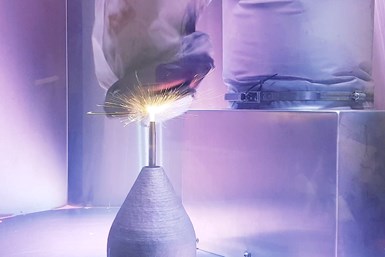Spee3D High-Velocity Phaser Nozzle for Faster Print Speeds
The company says the nozzle uses compressed air or nitrogen to deposit material four times faster than the speed of sound at much higher energy.

Photo Credit: Spee3D
Spee3D says its Phaser Nozzle is an ultra high-energy nozzle designed to work with the company’s cold spray metal 3D printers, a wide range of hard-phase materials and with a significant increase in deposition velocity. It is said the nozzle can create parts in just minutes to withstand severe conditions, high stress, immense shock loads and abrasive environments.
According to the company, its cold spray metal 3D printers are already some of the world's fastest, most robust, deployable additive solutions to manufacture full-density, solid metal parts in just minutes. It is said the nozzle uses compressed air or nitrogen to deposit material four times faster than the speed of sound at much higher energy. Also, this process is said to achieve high particle velocity to enable more deformation of particles during the deposition process. As a result, harder materials can be made, including stainless steel, titanium, high-strength aluminum and nickel-based carbides. These materials are in addition to Spee3D’s standard copper, aluminum bronze and aluminum materials.
It is said the cold spray process is high-speed, consistent and able to produce high-quality applications every time. The company says this technology is used worldwide and proven reliable by customers including the Australian Army, EWI, Penn State Applied Research Laboratory and other global organizations that require fabricating parts in harsh expeditionary field environments. With the Australian Army, the company has tested and validated metal 3D printing as a military capability with the latest field trial being the longest and toughest to date taking place in remote Northern Territory, alongside the Koolendong exercise.
Related Content
-
AM 101: What Is Binder Jetting? (Includes Video)
Binder jetting requires no support structures, is accurate and repeatable, and is said to eliminate dimensional distortion problems common in some high-heat 3D technologies. Here is a look at how binder jetting works and its benefits for additive manufacturing.
-
10 Important Developments in Additive Manufacturing Seen at Formnext 2022 (Includes Video)
The leading trade show dedicated to the advance of industrial 3D printing returned to the scale and energy not seen since before the pandemic. More ceramics, fewer supports structures and finding opportunities in wavelengths — these are just some of the AM advances notable at the show this year.
-
How to Build 10,000+ Shot Molds in Hours
Rapid tooling isn’t so rapid when it takes days to 3D print a metal mold, and then you still must machine it to reach the necessary tolerances. With Nexa3D’s polymer process you can print a mold in hours that is prototype or production ready and can last for more than 10,000 shots.






.png;maxWidth=300;quality=90)






